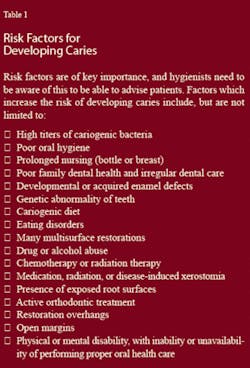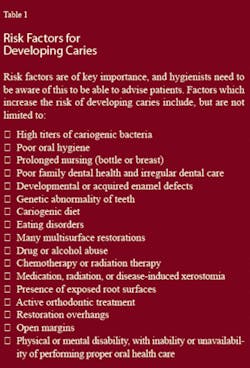How to add $20,000 per year to your hygiene revenue
by Annette Ashley Linder, BS, RDH
For all the years I have been in dentistry, one of our main goals has been to reduce the caries rate in the patient population. For awhile, the dental profession succeeded in doing so. But did you know that for the last several years, the caries rate in America has turned around and is on the upswing?
There are several reasons for the upturn. These include poor diet, access to dental care, and longevity. Thanks to science, modern medicine, and drugs, we are now living longer. While this is good news, it is not unusual for dental providers to see more gingival recession in patients. Recession may be the result of the aging process, occlusal considerations, improper brushing and home care, periodontal imflammation and infection, etc. Whatever the etiology, the final result is a higher incidence of root caries.
This trend is not just seen in our older patients. According to the National Institute of Dental Research Studies, 7 percent of 18-year-olds and as high as 21 percent of 35-year-olds have already suffered from one or more teeth with root caries.
So why are we not recommending topical fluoride treatments to our “at-risk” adult patients? Patients presenting with sensitivity, high caries rate, poor diet, medically compromised, recession, and xerostomia are ideal candidates. Xerostomia is becoming more and more prevalent in the population, as many patients routinely take prescription drugs that induce dry mouth. Why are we not prescribing and/or dispensing prescriptive home fluorides to these patients when we know the benefits? The short answer that I get from many hygienists and staff is that “insurance won’t pay for it and I know my patient won’t go for it.” You bet they won’t accept it if you say, “Mr. Smith, you would benefit from a fluoride treatment, but I am pretty sure your insurance won’t pay for it.”
In my consulting work, I routinely hear patients tell the hygienist to “stay away from this tooth because it is really sensitive.” In this scenario the patient is literally asking for a remedy. This is the ideal time to show the patient (use a mirror or the intraoral camera) the recession, the root, the cervical abrasion, the white spot precavity lesion, etc. It also is the ideal time to briefly share the research with the patient and describe the benefits of a professionally-applied topical fluoride treatment. The hygienist advises the patient that “we can accomplish the treatment today at the completion of the prophylaxis. This will help to remineralize tooth surface (or) reduce the sensitivity and strengthen your teeth.”
The hygienist continues by saying, “My concern is that, as you can see, the root of your tooth is exposed. The roots of the teeth are covered with cementum, which is not as strong as enamel.” If the patient is caries-prone and at risk, the hygienist discusses this and advises the patient that “we are trying to prevent the root from decaying or getting a cavity.”
Many of my clients’ offices have oral health, home-care, professional-display centers where patients have the opportunity to purchase the best professional oral home-care products in the office. Typical products include power toothbrushes, malodor and oral medicaments, intraoral cleaning devices, irrigators, fluoride toothpaste, etc. Oral health home-care products make great gifts, and displaying them as such help peak the patients’ interest. (Example: a big red bow on a Sonicare® box at the front desk with signage saying, “Give the gift of good health to your special Valentine.”)
The ADA published a special report (see JADA insert, May 2006, titled “Professionally Applied Topical Fluoride; Executive Summary of Evidence-Based Clinical Recommendations”) on this research. This report contained the clinical recommendations developed by an expert panel established by the ADA Council on Scientific Affairs. The research team evaluated a collective body of scientific evidence on the effectiveness of professionally-applied topical fluoride for caries prevention.
As stated in the report, general panel conclusions included the following:

